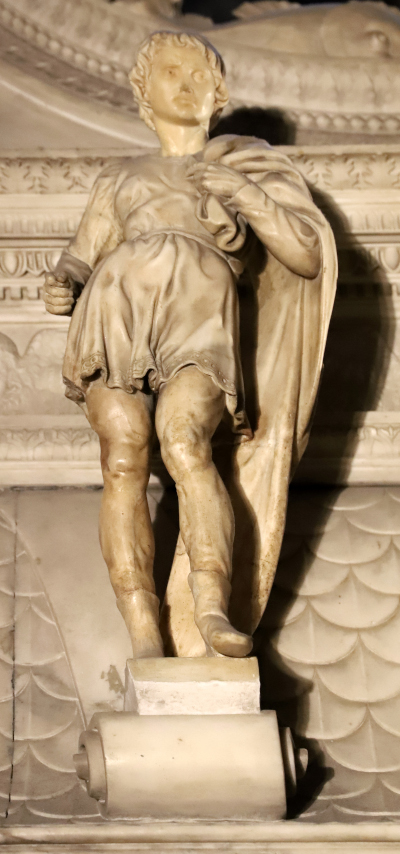Introduction
The overall commission had been for the Arca di San Domenico in the Italian city of Bologna, with the other two sculptures involved being a small angel holding a candlestick, as well as St Petronius, which followed a similar format to the sculpture listed in this page. Michelangelo had a tendency to leave commissions unfinished right across his career, but in this case he was left with very clear boundaries, due to the work already completed, and so was able to fulfil his obligations.
Michelangelo was fairly young at this point, and later on in his career may not have been willing to accept a commission in this manner. The confident artist normally requested a considerable scope of creativity and decision making, but when building up his brand in the early years, he was forced to be a little more flexible. He was famed for his arrogance, particularly in later life, but with this project he was able to adapt to what had gone before, with contributions coming from the likes of Nicola Pisano, Arnolfo di Cambio and Niccolò dell'Arca.
Those fortunate enough to view the St Proculus sculpture in person will see a vibrant work, in which a confident soldier looks over us all. His image is designed around Michelangelo's ideal image of the male body, rather than the typical manner in which male soldiers might be depicted. The sculptor appreciated toned figures, rather than huge muscle mass, and this is highlighted in his many sketches of the male anatomy. In terms of frame, it is somewhat similar to his famous David.
St Proculus' limbs are carefully angled to roughly follow the edges of his torso. This may have been simply a stylistic decision from Michelangelo, but alternatively it may have been due to the nature of the stone used, marble, which can leave smaller parts of any sculpture to be vulnerable. By allowing them to remain alongside the main structure, they would be less likely to become damaged over time, although the sculpture has rarely been moved over the years and so it likely would have survived in this condition in any case.
Table of Contents
- Introduction
- Who was Saint Proculus of Bologna?
- Description
- Commission and Payment
- Basilica of San Domenico, Bologna
- Size and Medium
Who was Saint Proculus of Bologna?
Saint Proculus the Soldier died in around 304 AD and was to become a saint. He was martyred in the Italian city of Bolgona, and so is considered a local hero within this community. He was buried in the city, at the church of San Procolo, and was famous for standing up to the unfair treatment of others, ultimately leading to his own death. His strong connection to the city of Bologna was the reason behind his inclusion within this high profile project, which attempted to celebrate the best that this region had to offer within the stunning tomb.
Description
The sculpture itself features Saint Proculus standing in a confident manner, with his cape thrown over his left shoulder. His figure appears somewhat slight, rather than the physically imposing nature of most depictions of respected soldiers from around this time. Indeed, his facial features are almost angelic, and there is nothing to suggest the brutal murder with an axe that he inflicted upon Marinus as revenge for his own cruelty.
The saint is dressed in a traditional robe which runs down to just above the knee. His legs are exposed, with a pair of simple ankle high boots. There is perhaps a small belt around his waist, but the main point of interest here is the beautiful drapery implemented by Michelangelo right across his clothing.
The figure looks outwards into the distance with a clarity of thought and clear confidence. He was depicted as a young man, which is how Michelangelo liked to display most of his figures, even when sometimes that might not be faithful to the particular individual story behind each sculpture. Michelangelo loved to maximise the benefits of working in three dimensions, by offering light as much opportunity as possible to reflect and shadow around the various curves and hollow sections of his creations.
Indeed, he would continue this into his paintings, working hard to create similar effects, normally through an incredible handling of shading and colour. His drawings best indicate the raw talents that he possessed and honed over years of practice. His attention to his sculptures from multiple angles also makes it worthwhile walking around his sculptures, to enjoy different experiences as one does so.
Commission and Payment
No records exist for the payment received by Michelangelo for this sculpture, but we can fairly accurately estimate it from the knowledge that we do have. He received twelve ducats for his angel sculpture plus another eighteen ducats for St Petronius, and with the latter have been partly completed prior to Michelangelo taking over the project, one might assume that he received slightly more than that for Saint Proculus, which was probably produced entirely from scratch.
It is believed that Gianfrancesco Aldovrandi organised this commission, and he stepped in fairly soon after the death of Niccolo dell'Arca, who himself was responsible for all of the figures originally added to the shrine. It was fairly commonplace within the Renaissance era for projects to be delayed and to pass through several different artists for a number of reasons. The larger projects could take many years to complete, making issues such as these far more likely.
Basilica of San Domenico, Bologna
The Basilica of San Domenico holds the remains of Saint Dominic, who was the founder of the Order of Preachers (Dominicans). The Arca di San Domenico was set up in his name as a shrine, and the finest architects and sculptors available in Italy were sought for its construction. Ultimately, it would be Nicola Pisano, followed by Arnolfo di Cambio, who completed most of the work, with additional, individual sculptures then being added on afterwards by Niccolò dell'Arca and Michelangelo.
The church itself features plenty more to see, including a large number of side chapels, each of which offer additional artworks from the Renaissance era. Some of the other famous artists whose work is featured within the church include Giunta Pisano, Filippino Lippi and Guido Reni, helping to make this one of the most significant cultural points of interest in all Bologna.
Size and Medium
St Proculus from the Basilica of San Domenico in Bologna is 58.5 cm tall, making it just slightly shorter than St Petronius. Both items were completed entirely in marble during the period of 1494–1495, during which the Angel sculpture was also constructed.
Image Credit
The image of the sculpture displayed in this page is used under the Creative Commons Attribution 3.0 Unported license and has been resized into a smaller format. The original contributer was Sailko, via Wikimedia who added a number of his own photographs of the Tomb of St Dominic to the Wikimedia resource and their contribution is much appreciated.
Saint Dominic's ark, 1494-1495 by Michelangelo, sculpture of Saint Proculus the Soldier; Sailko, CC BY 3.0, via Wikimedia Commons
Bibliography
- Images sourced from Wikimedia under a variety of Creative Commons licenses. Further details regarding the particular license used, the location of the original image on Wikimedia and the original author/user are provided on each specific page.
- Michelangelo, Gilles Néret
- Vasari's Lives of the Artists, Giorgio Vasari
- Michelangelo. The Complete Works. Paintings, Sculptures, Architecture, Frank Zöllner, Christof Thoenes
- Michelangelo and the Sistine Chapel, Andrew Graham-Dixon





